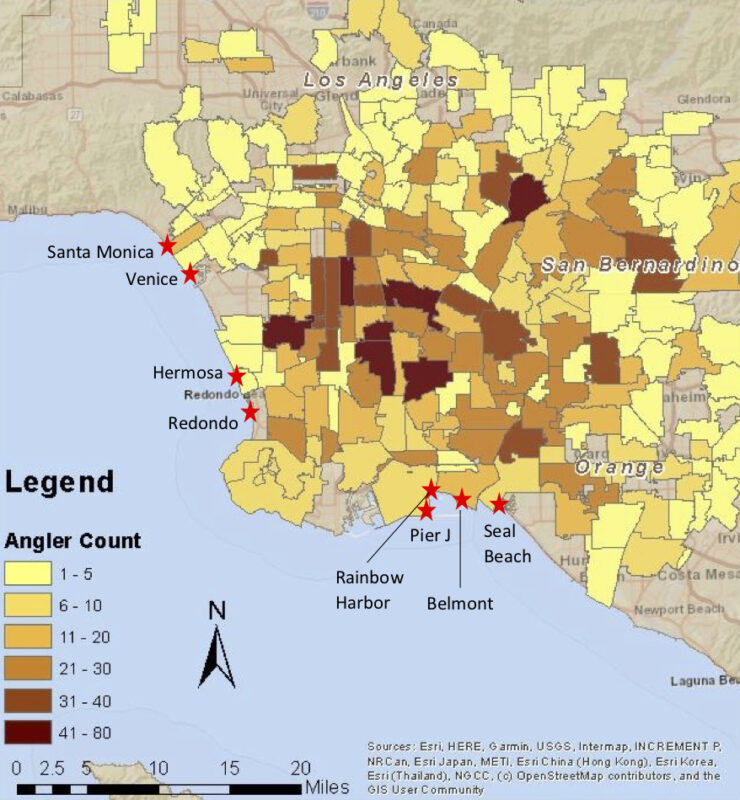Learning About LA’s Vibrant Community of Anglers

Heal the Bay’s Angler Outreach Program, through the EPA’s Fish Contamination Education Collaborative (FCEC), has been visiting eight Los Angeles County and Orange County piers throughout the last 17 years, talking to anglers about fish contamination and how to stay safe and healthy. Many anglers come to the coast to catch fish to eat for themselves and their families. Our previous research indicates that 78% of pier anglers fish for subsistence.
To better understand the local angler community, our outreach team collects zip code information from individuals fishing on piers and along the coast. We recently analyzed this survey data from 2018 and 2019. Our findings help us understand where anglers are located and how to better serve them.

In 2019, we talked to 8,488 anglers and collected zip codes from 3,052 of those anglers. We collect zip codes only from anglers who are surveyed for the first time. Most of the zip codes (3,001) were from California. The rest were likely tourists and visitors. We even talked with some anglers from as far away as Alaska — fishing in Alaska is surely different than LA!
In both 2018 and 2019, one location had the highest density of anglers surveyed: Hawthorne (90250), a city in the South Bay in southwestern LA County bordered by the 105 freeway on the north and the 405 freeway on the west. According to the LA Times and census data, Hawthorne is a diverse area in the South Bay and LA County with a 44.2% Hispanic, 32.4% Black, 12.9% White, and 7.6% Asian population.
In both 2018 and 2019, a few areas showed up in the top five zip codes of anglers: Compton and Willowbrook (90222), Long Beach (90805), and South El Monte (91733).
In both years, many anglers hailed from areas in the San Gabriel Valley, including South El Monte and Rosemead. The demographics of these two areas differ greatly: South El Monte has a predominantly Hispanic (86.2%) population; Rosemead has an Asian (48.6%) and Hispanic (41%) population.
It has been widely shown that People of Color are disproportionately impacted by pollution. This environmental injustice includes air pollution, water pollution, waste dumping, oil drilling and refining, fish contamination, and more. Many communities where anglers live have high pollution burdens on CalEnviroScreen, a tool that compiles environmental, health, and socioeconomic information to produce a score showing which communities are most affected by and most vulnerable to pollution.
It is imperative that our Angler Outreach Program reaches people effectively in order to protect public health. In example, if anglers speak Spanish, Chinese, and Vietnamese as their first language, warning signage and other resources about fish contamination that are written in English may not be effective. Our Angler Outreach Program has employed multilingual team members who directly engage local anglers about fish contamination and how to stay safe. We have produced educational materials and resources in English, Spanish, Chinese, and Vietnamese.
Using the results of our zip code survey, we created a heat map of where anglers are located in Los Angeles County, and through it we see many opportunities for additional outreach in specific areas. Ensuring there is accessible and relevant information across Heal the Bay’s programs, especially in top angler zip codes, can increase the number of people we reach and maximize impact.

It is interesting to also use our zip code survey analysis to gauge how effective other Heal the Bay programs are at reaching angler communities. Heal the Bay Aquarium hosted 24 field trips for 1,217 students from schools in the top angler zip codes* in 2017. Heal the Bay’s Speakers Bureau Program gives free talks (previously in-person and now virtually) throughout LA County, and we gave 39 talks to 2,985 people in the top angler zip codes* in 2017. While Heal the Bay conducts outreach and provides education in many of the communities where anglers are located, there is ample room for growth and a lot more to be done! We are excited to continue our analysis and find new ways to engage anglers and their families with helpful information.
*Zip codes with 31-80 anglers in 2018 and 2019.
Learn more about the Angler Outreach Program:


